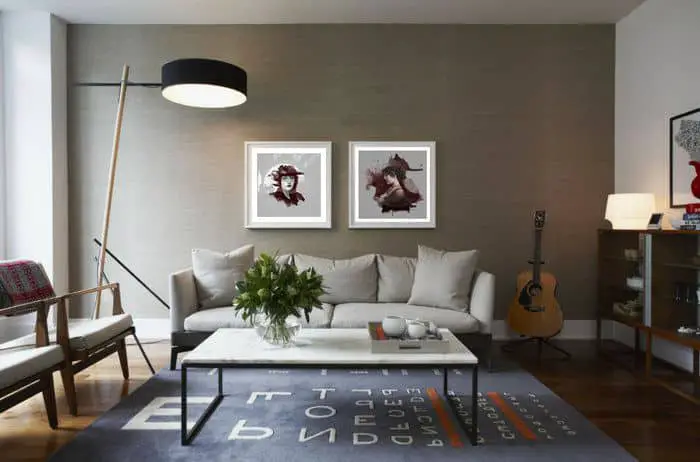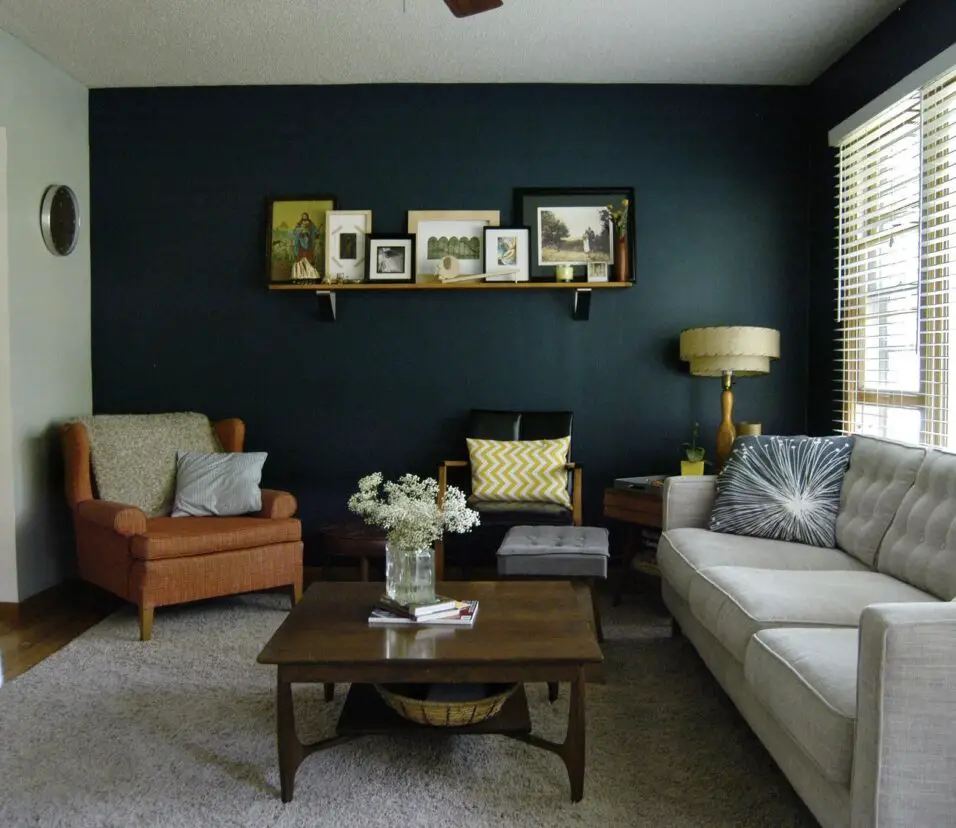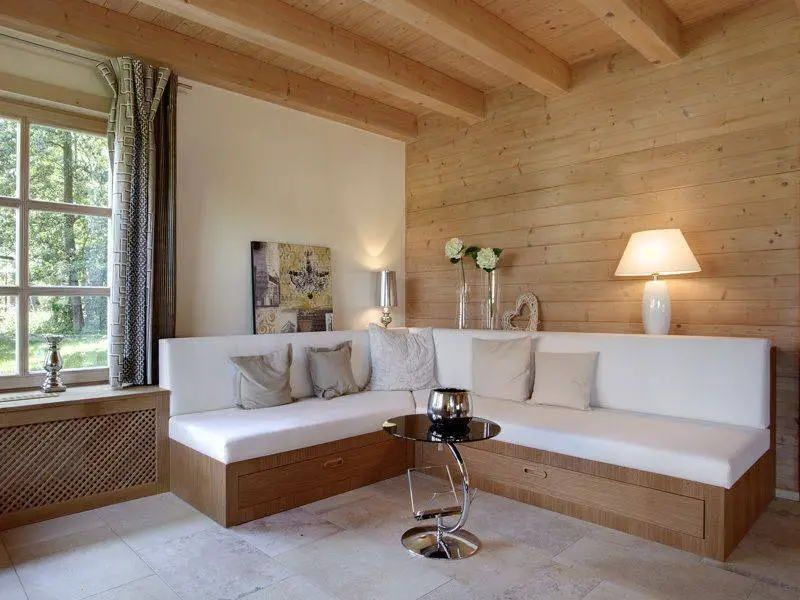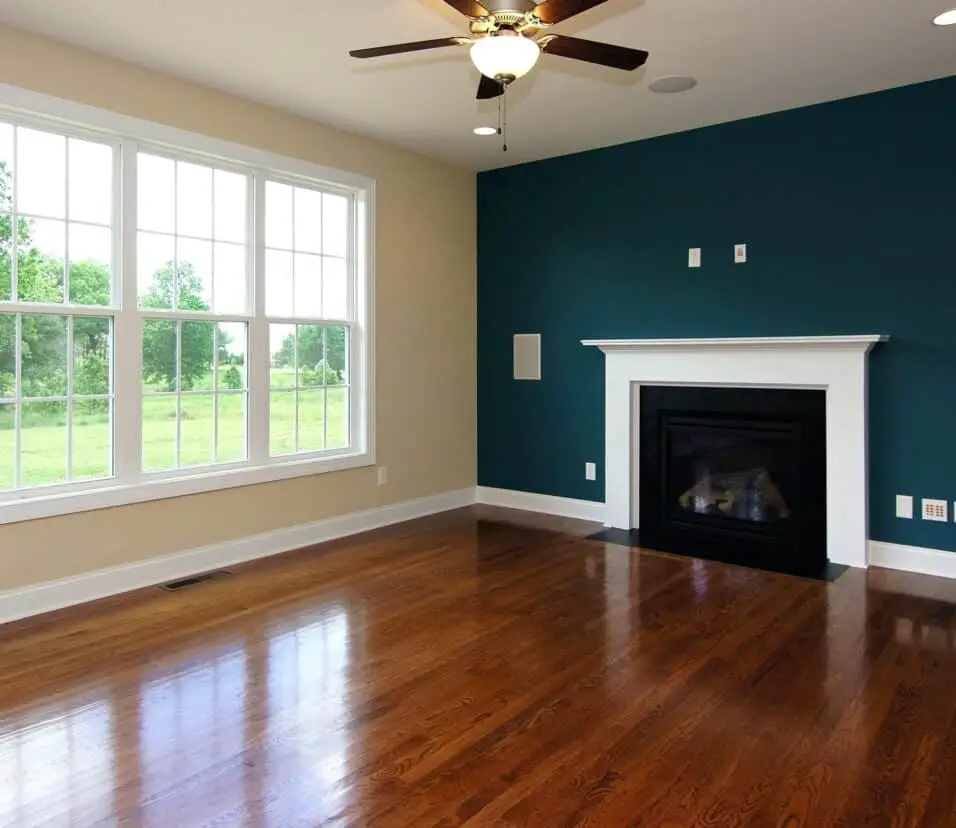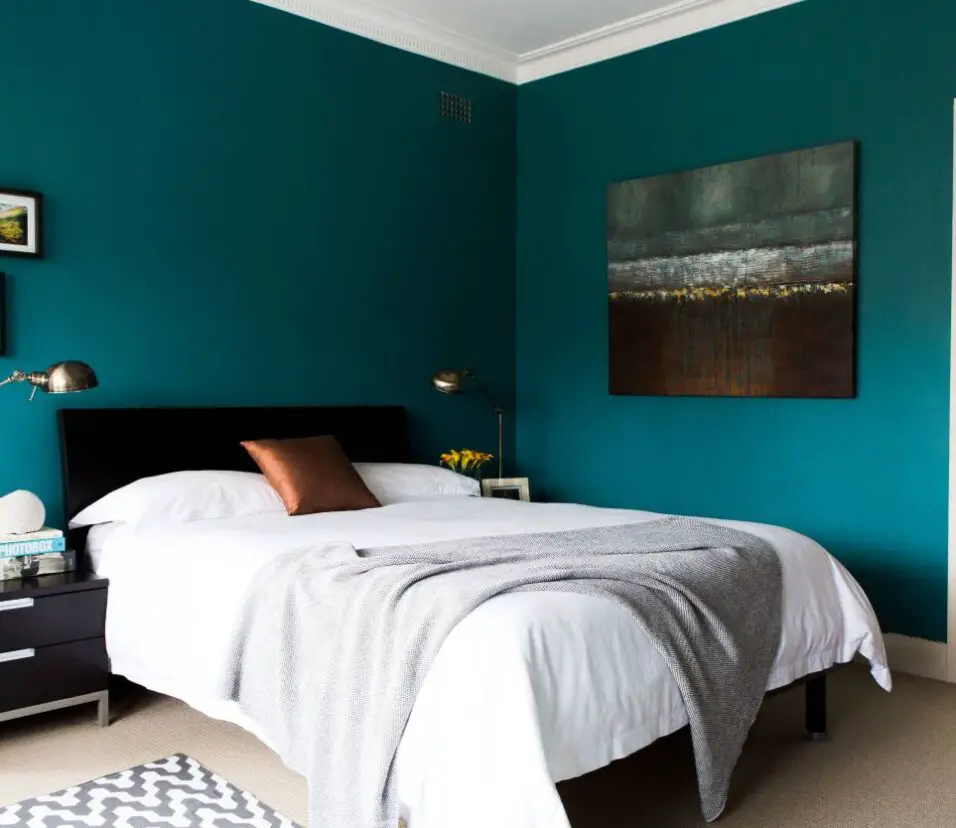Do Accent Walls Make Room Smaller
Introduction
Does Accent Walls Make Room Smaller? Accent walls have become a trendy interior design concept. These walls are usually painted or adorned in a different color or pattern than the rest of the room. To provide a focal point and visual intrigue. Accent walls may shrink a room, but this is debatable. This post will discuss how accent walls effect room space.
First, an accent wall’s effect on a room’s size depends on various elements. Accent wall color and pattern, as well as room arrangement and design, can affect how the area is viewed. A dark accent wall in a small room may make it appear smaller. Whereas a light accent wall in a large room might make it feel larger.
Second, the room’s accent wall placement might change space perception. Accent walls usually accent a fireplace or bed. The accent wall can provide depth and complexity to the room by calling attention to these items. However, if the accent wall disrupts the room’s flow or forms a visual barrier. It may make the area appear smaller.
Finally, examine the homeowner’s design choices and aims. Some individuals want their rooms snug and private, while others like them open and expansive. An accent wall should support these goals and meet the room’s needs. By choosing the accent wall’s color, pattern, and placement, you may create a visually appealing environment that adds size.
Accent walls’ effect on room size is not uniform. It varies on color, design, positioning, and personal taste. Accent walls can add depth, dimension, and visual interest to a room without shrinking. It by considering these variables and making intelligent design decisions.

Do accent walls make rooms look bigger or smaller?
Because they add extra details, accent walls break up the space. Making it feel bigger the same way an area rug does to a floor. Even darker colors that would otherwise make a room feel smaller. Will make a room feel bigger when you use them for an accent wall.
Accent walls have become a popular trend in interior design. Offering a way to add visual interest and personality to a room. The concept involves painting or wallpapering one wall in a different color or pattern than the rest of the room. However, when it comes to the impact on the perceived size of a room, opinions are divided. Some argue that accent walls can make a room look bigger, while others believe they can make it appear smaller. In this article, we will explore both perspectives and provide a comprehensive analysis of how accent. Walls can affect the perception of room size.
Perception of Size
One school of thought suggests that accent walls can make a room look bigger. By drawing attention to a specific wall. It creates a focal point that diverts the viewer’s attention away from the overall dimensions of the space. This can create an illusion of depth and make the room feel more expansive. Additionally, using lighter colors or patterns on the accent wall can reflect more light. Making the room appear brighter and airier.
On the other hand, some argue that accent walls can make a room look smaller. This perspective emphasizes the importance of visual continuity and flow within a space. When one wall stands out from the rest. It can disrupt the harmony and coherence of the room, making it feel disjointed and cramped. This effect is particularly noticeable in smaller rooms. Where the accent wall can create a sense of enclosure and limit the perceived size of the space.
Considerations for Room Size
When deciding whether to incorporate an accent wall, several factors should be taken into account. Firstly, the size of the room plays a crucial role. In larger rooms, accent walls can be used strategically. To break up the space and add interest without overwhelming the overall dimensions. In contrast, smaller rooms may benefit from a more cohesive color scheme to create an illusion of spaciousness.
Furthermore, the choice of color and pattern for the accent wall is essential. Lighter colors, such as pastels or neutrals, tend to reflect more light and create a sense of openness. Conversely, darker or bold colors can make a wall appear closer, resulting in a cozier atmosphere. Similarly, patterns can influence the perception of size, with vertical stripes elongating the wall and horizontal patterns widening it.
What accent walls make a room look bigger?
Stark White. Naturally, white is an obvious choice for making a room feel bigger. It’s no secret that light colors make a room look larger, especially if the space is bathed in natural light. Eggshell or satin finishes will help reflect the light, creating the appearance of even more space.
can be a great way to add visual interest and depth to a room. Not only do they create a focal point, but they can also make a room look bigger. If chosen and executed correctly. When it comes to choosing the right accent wall color or design, there are a few key factors to consider. By understanding these factors and following some simple guidelines. You can create an accent wall that enhances the perceived size of your room.
One important consideration when choosing an accent wall color is to opt for Light colors have the ability to reflect more light. Making a space feel more open and airy. By painting one wall in a lighter shade, you can create the illusion of a larger room. For example, using pastel hues like soft blues, pale pinks or light grays can help make a room appear more spacious.
In addition to choosing lighter colors, it’s also important to consider of your accent wall. Typically, the best wall to choose as an accent wall is the one that naturally draws attention, such as the wall behind a bed or a fireplace. By highlighting this wall, you can create a sense of depth and dimension, which can make the room feel larger. Additionally, choosing a wall with architectural features, such as a unique shape or interesting texture, can further enhance the visual appeal of the space.
Another effective way to make a room look bigger with an accent wall is to Placing a large mirror on the accent wall can create the illusion of additional space by reflecting light and making the room feel more open. Mirrors not only add a decorative element to the room but also serve a functional purpose in making the space appear larger than it actually is.
What does an accent wall do to a small room?
An accent wall will completely change the entire feel of the sleeping area, undoubtedly improving it for the better. It adds a touch of depth, suspense, and elegance, without completely changing the foundations of the bedroom. The method can be as easy as painting the wall in a distinct color.
A modest room’s appearance can be greatly improved with an accent wall. You may draw attention and add depth to a room by strategically highlighting a wall. An accent wall can make a space look bigger, add visual interest, or set a mood.
Small rooms benefit from accent walls since they make the area appear larger. Painting or wallpapering one wall a lighter or brighter hue makes it recede, making the room appear larger. When the accent wall is opposite the entryway, it leads the eye deeper into the space, making it feel larger.
An accent wall can make a tiny room look bigger and add charm. An accent wall in a strong color or design may liven up a dull room. This is especially useful in tiny areas with restricted design and furniture placement.
An accent wall can also set the mood in a tiny room. A bedroom or reading nook with a deep, rich color like navy blue or forest green can be comfortable and personal. However, a bright color like yellow or orange can energize and warm a tiny living room or kitchen.
An accent wall can transform a modest area. It can provide visual appeal, make the space look bigger, and set the mood. By choosing the right accent wall color or pattern, you can make a tiny room look big and inviting, reflecting your style and improving your home’s appearance.
Does an accent wall make a room feel bigger?
An accent wall, a familiar term in the design world, is a wall that differs in design from the rest of the walls present in the room. When used correctly, accent walls can enhance your interior design and create the illusion of a larger room.
Color on an accent wall may expand a room. Choose a lighter or brighter accent wall color to reflect light and make the area appear larger. Lighter colors expand a room, whereas darker colors close it. Choosing a light or bright accent wall color might make the area appear larger.
Along with color, texture can make a room feel bigger. Reclaimed wood or exposed brick accent walls provide depth and character to the space. Texture invites attention and makes the room feel bigger and more vibrant. The textured accent wall gives depth and makes the room appear larger than the plain walls.
Pattern can also expand a room with an accent wall. A patterned wallpaper or wall mural on the accent wall adds visual interest and depth. The pattern pulls the eye and gives the room movement, expanding it. Vertical line patterns can also make a room appear taller and larger.
Accent walls may make a space feel bigger. Color, texture, or pattern on an accent wall creates visual interest and depth, making the area appear larger. By carefully choosing accent wall pieces, a basic space can become aesthetically appealing and expansive.
What are the cons of accent wall?
Because an accent wall is designed differently from its surrounding walls, it may feel out of place and dividing. If not done right, it would only chop up your space, and feel randomly placed, instead of actually being the highlight of the room.
Accent walls are painted or decorated differently from the others. It often adds visual interest or creates a focal point. Accent walls can enhance a room’s beauty, but they also have negatives that should be considered before installing them.
Finally, accent walls may appear cluttered. If the accent wall is busy or has too many decorations, the space can feel cramped. An eye-catching accent wall must be balanced with the space’s simplicity and openness. Colour, pattern, and scale all be considered when choosing an accent wall to match the room’s decor.
Accent walls may make a room appear larger. Using a distinct color or pattern on one wall creates a focal point and can make the room feel larger or smaller depending on the design. Strong or dark colors on accent walls make them stand out and shrink the room. Using a light or neutral color might make the wall disappear, making the area appear larger.
The accent wall’s placement can also create the illusion of a larger room. If put on the wall farthest from the entry, the accent wall can add depth and length. If the accent wall is on a side wall, it may expand the area. Accent walls’ influence on space depend on room size and shape. Accent walls can differentiate regions and create visual interest in larger rooms while fostering intimacy and comfort in smaller spaces.
How do accent walls affect the overall visual perception of room dimensions?
Accent walls can have a significant impact on the overall visual perception of room dimensions. By strategically placing a bold and contrasting color or pattern on one wall, it creates a focal point that draws the eye and diverts attention from the actual size of the room. This can make the room appear larger or smaller, depending on the desired effect.
When an accent wall is painted in a darker shade than the surrounding walls, it can create the illusion of depth and make the room feel more spacious. This is particularly effective in smaller rooms where the goal is to make them appear larger. On the other hand, if the accent wall is painted in a lighter shade, it can visually expand the space and make it feel more open and airy.
Additionally, the placement of the accent wall can also influence the perception of room dimensions. Painting the wall at the far end of the room can create a sense of depth and make the room appear longer. Conversely, painting the wall on one side can visually widen the space. By strategically choosing the location of the accent wall, it is possible to manipulate the perception of room dimensions and create a desired visual effect.
Are there specific colors or patterns for accent walls that can make a room appear smaller?
When it comes to creating the illusion of a smaller room using accent walls, the choice of colors and patterns plays a crucial role. Darker colors tend to absorb light and can make a room feel more enclosed, thus giving the perception of a smaller space. Deep shades such as navy blue, charcoal gray, or even a rich burgundy can create a cozy and intimate atmosphere, making the room appear smaller than it actually is.
Patterns can also contribute to the visual perception of room dimensions. Bold and busy patterns can make a space feel more crowded and compact. Opting for intricate designs or large-scale patterns on an accent wall can visually shrink the room, as the eye is drawn to the detailed elements. This can be particularly effective in rooms with high ceilings or open floor plans, where creating a sense of coziness and intimacy is desired.
Do accent walls have a psychological effect on the perception of space in a room?
Yes, accent walls do have a psychological effect on the perception of space in a room. The use of an accent wall can create a sense of depth and dimension, making the room appear larger or smaller depending on the chosen color and pattern. The human brain is wired to interpret visual cues, and accent walls can manipulate these cues to alter our perception of space.
When a bold or dark color is used on an accent wall, it tends to visually recede, creating an illusion of depth. This can make a small room appear larger by pushing the walls back and creating a sense of expansiveness. On the other hand, if a light or bright color is used on the accent wall, it can visually advance, making the room feel more intimate and cozy.
The psychological effect of accent walls on the perception of space is not limited to color alone. Patterns and textures can also play a role. For example, vertical stripes on an accent wall can make the ceiling appear higher, giving the impression of a taller room. Similarly, horizontal stripes can make a room seem wider. By strategically choosing colors, patterns, and textures for accent walls, one can effectively manipulate the perception of space in a room.
Do accent walls have a psychological effect on the perception of space in a room?
Yes, accent walls can indeed have a psychological effect on the perception of space in a room. The use of an accent wall can create a visual focal point, drawing attention to a specific area and diverting attention from the overall size of the room. By strategically placing an accent wall, you can manipulate the perception of space and make a room appear larger or smaller.
When an accent wall is painted in a darker color than the surrounding walls, it can create an illusion of depth and make the room feel smaller. This is because darker colors tend to visually recede, giving the impression of a shorter distance. On the other hand, if the accent wall is painted in a lighter color, it can make the room feel more spacious and open. Lighter colors reflect more light, creating a sense of airiness and expansiveness.
Furthermore, the placement of an accent wall can also impact the perception of space. If the accent wall is positioned at the far end of a long, narrow room, it can visually shorten the length and make the room feel more balanced. Conversely, if the accent wall is placed on one of the shorter walls in a square or rectangular room, it can create the illusion of width and make the room appear larger.

Conclusion
Based on the array “”do accent walls make room smaller,”” accent walls might make a space appear smaller. This effect varies by color, room size, and design. Before installing an accent wall, consider these things.
Dark or dramatic colors on accent walls can make a room appear smaller. Dark colors absorb light, making walls appear smaller and retreat. This effect is especially obvious in smaller rooms where every inch counts. Thus, if you have a tiny room and want to make it appear larger, avoid dark or dramatic accent wall colors.
Accent walls are a good choice for larger rooms or those seeking depth and visual intrigue. Your accent wall can pull the attention and give dimension to the room without cramping it by utilizing lighter or neutral hues. Accent walls can also emphasize architectural characteristics or provide balance and harmony in the design.
Consider how the accent wall’s size and placement affect the room’s feeling of space. For instance, painting a modest accent wall on one side of a bigger room may not change its overall size. However, painting all the walls in a tiny space a strong color might make it feel more constricted and personal.
In conclusion, accent walls can make a space appear smaller, but this effect is variable. Color, room size, and design determine whether an accent wall adds or subtracts space. Therefore, when adding accent walls to your home design, you must carefully evaluate these variables and make an informed selection.




